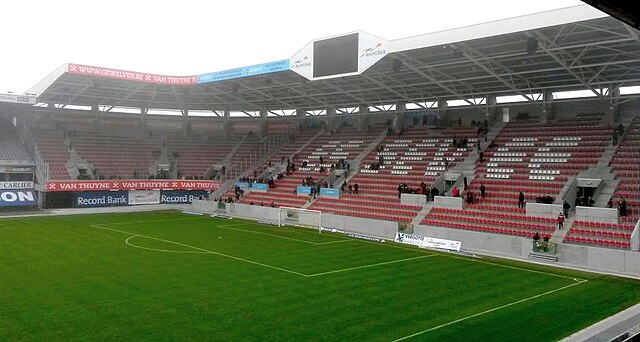Loading AI tools
Waregem
Municipality in Flemish Community, Belgium From Wikipedia, the free encyclopedia
Waregem (Dutch: [ˈʋaːrəɣɛm] ; West Flemish: Woaregem [ˈβɒːrəɦæm]), sometimes known by the older spelling of Waereghem, is a municipality and city located in the Belgian province of West Flanders. The municipality lies in the valley of the river Leie, between Kortrijk and Ghent. It is part of the arrondissement of Kortrijk and comprises the towns of Beveren, Desselgem, Sint-Eloois-Vijve and Waregem proper. On January 1, 2019, Waregem had a total population of 38,260. The total area is 44.34 km² which gives a population density of 863 inhabitants per km².
Waregem
| |
|---|---|
 City parish church located on the marketplace | |
| Coordinates: 50°53′N 03°25′E | |
| Country | |
| Community | Flemish Community |
| Region | Flemish Region |
| Province | West Flanders |
| Arrondissement | Kortrijk |
| Government | |
| • Mayor | Kurt Vanryckeghem |
| • Governing party/ies | CD&V |
| Area | |
| • Total | 44.5 km2 (17.2 sq mi) |
| Population (2020-01-01)[1] | |
| • Total | 38,347 |
| • Density | 860/km2 (2,200/sq mi) |
| Postal codes | 8790-8793 |
| NIS code | 34040 |
| Area codes | 056 |
| Website | www.waregem.be |
The first inhabitants of this forested region settled along the Leie well before Roman times. Bronze coins and artifacts associated with the Gallo-Roman culture show extensive activity in this area in the first centuries of our era. This is not surprising given the fact that Sint-Eloois-Vijve stood at the intersection of two important Roman roads: Cassel-Tongeren and Bavai-Oudenburg. The name of the current municipality refers to a certain “Waro” clan or tribe, possibly dating from the Frankish period.

In the 10th century, most of Waregem's territory was given as a grant to the St Peter Abbey in Ghent. The local administrative center used by the Benedictines along the Leie River can still be seen today and is still known as the Munkenhof. At the end of the century, Baldwin IV, Count of Flanders, made this area the base from which he could advance against Kortrijk. During the following centuries, the medieval feudal system allowed the land to be progressively parceled out to landowners from places as far as Dendermonde and Tournai. At that time, like in the rest of Flanders, most of the population consisted of farmers, spinners and weavers. Tax documents from the 13th century attest to the strong economic activity of the time. Waregem's attempt in 1635 at obtaining rights to hold its own market was opposed by the neighbouring towns. A Saturday market was finally approved by Joseph II of Austria in 1784.
Much of the medieval land ownership structure remained unchanged until the end of the 18th century, when the town counted some 4,500 inhabitants. The construction of the main roadway between Kortrijk and Ghent made possible the building of an important coaching inn on the territory of Waregem, where horses could be hired. The French Revolution brought severe religious restrictions in its wake; it also gave the region a modern administrative system and more political autonomy. During the 19th century, the old textile economy went into decline. The proximity of the Leie River, however, was a boon for Waregem, as its flax industry drove the local economy until well into the 20th century. Waregem earned its official city title on January 1, 2000.




Seamless Wikipedia browsing. On steroids.
Every time you click a link to Wikipedia, Wiktionary or Wikiquote in your browser's search results, it will show the modern Wikiwand interface.
Wikiwand extension is a five stars, simple, with minimum permission required to keep your browsing private, safe and transparent.